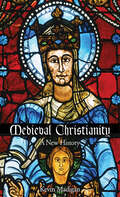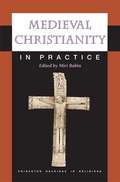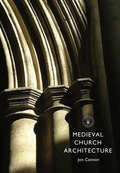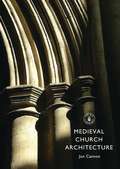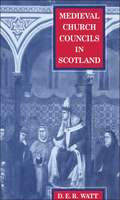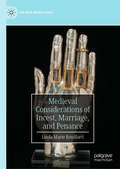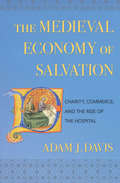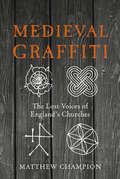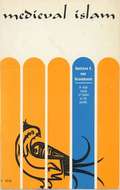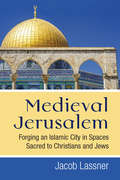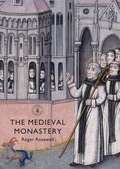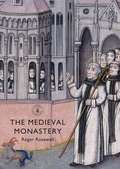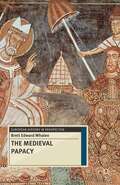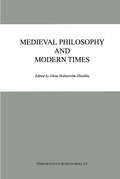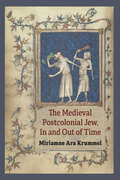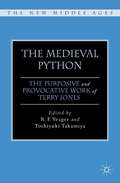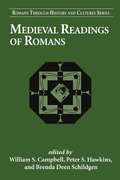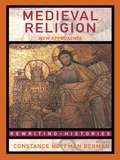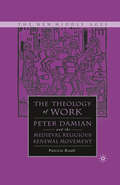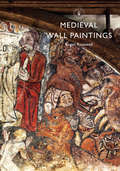- Table View
- List View
Medieval Christianity: A New History
by Kevin MadiganFor many, the medieval world seems dark and foreign—a miraculous, brutal, and irrational time of superstition and strange relics. The pursuit of heretics, the Inquisition, the Crusades and the domination of the “Holy Land” come to mind. Yet the medieval world produced much that is part of our world today, including universities, the passion for Roman architecture and the emergence of the gothic style, pilgrimage, the emergence of capitalism, and female saints. This new narrative history of medieval Christianity, spanning from A.D. 500 to 1500, attempts to combine both what is unfamiliar and what is familiar to readers. Elements of novelty in the book include a steady focus on the role of women in Christianity; the relationships among Christians, Jews, and Muslims; the experience of ordinary parishioners; the adventure of asceticism, devotion and worship, and instruction through drama, architecture, and art. Madigan expertly integrates these areas of focus with more traditional themes, such as the evolution and decline of papal power, the nature and repression of heresy, sanctity and pilgrimage, the conciliar movement, and the break between the old Western church and its reformers. Illustrated with more than forty photographs of physical remains, this book promises to become an essential guide to a historical era of profound influence.
Medieval Christianity in Practice (Princeton Readings in Religions #36)
by Miri RubinMedieval Christianity in Practice provides readers with a sweeping look at the religious practices of the European Middle Ages. Comprising forty-two selections from primary source materials--each translated with an introduction and commentary by a specialist in the field--the collection illustrates the religious cycles, rituals, and experiences that gave meaning to medieval Christian individuals and communities.This volume of Princeton Readings in Religions assembles sources reflecting different genres, regions, and styles, including prayer books, chronicles, diaries, liturgical books, sermons, hagiography, and handbooks for the laity and clergy. The texts represent the practices through which Christians conducted their individual, family, and community lives, and explores such life-cycle events as birth, confirmation, marriage, sickness, death, and burial. The texts also document religious practices related to themes of work, parish life, and devotions, as well as power and authority. Enriched by expert analysis and suggestions for further reading, Medieval Christianity in Practice gives students and general readers alike the necessary background and foundations for an appreciation of the creativity and multiplicity of medieval Christian religious culture.
Medieval Church Architecture (Shire Library)
by Jon CannonBritain is a treasure trove of medieval architecture. Almost every village and town in the land has a church that was built during the period, whose history is legible – to those who know how to look – in every arch, capital, roof vault, and detail of window tracery. By learning how to identify the stylistic phases that resulted from shifts in architectural fashion, it is possible to date each part of a church to within a decade or two; this book introduces all the key features of each succeeding style, from Anglo-Saxon and Norman through to the three great gothic styles, Early English, Decorated and Perpendicular. It will be indispensable to anyone who enjoys exploring medieval churches, and who wants to understand and appreciate their beauty more deeply.
Medieval Church Architecture (Shire Library)
by Jon CannonBritain is a treasure trove of medieval architecture. Almost every village and town in the land has a church that was built during the period, whose history is legible – to those who know how to look – in every arch, capital, roof vault, and detail of window tracery. By learning how to identify the stylistic phases that resulted from shifts in architectural fashion, it is possible to date each part of a church to within a decade or two; this book introduces all the key features of each succeeding style, from Anglo-Saxon and Norman through to the three great gothic styles, Early English, Decorated and Perpendicular. It will be indispensable to anyone who enjoys exploring medieval churches, and who wants to understand and appreciate their beauty more deeply.
Medieval Church Councils in Scotland
by Donald WattUniquely in the kingdoms of western Christendom, the Scottish bishops obtained authority, in 1225, to hold inter-diocesan meetings without a supervisory archbishop, and continued to meet in this way for nearly 250 years. Donald Watt provides an authoritative study of these church councils from the Latin and English records based on original sources.In addition to creating an original work of considerable historical interest, Professor Watt brings discussion of the councils and their significance into the broader context of Scotland's political, legal, ecclesiastical and social situation over a long period.An important contribution to Scottish church history and to its influence on contemporary affairs.
Medieval Considerations of Incest, Marriage, and Penance (The New Middle Ages)
by Linda Marie RouillardMedieval Considerations of Incest, Marriage, and Penance focuses on the incest motif as used in numerous medieval narratives. Explaining the weakness of great rulers, such as Charlemagne, or the fall of legendary heroes, such as Arthur, incest stories also reflect on changes to the sacramental regulations and practices related to marriage and penance. Such changes demonstrate the Church's increasing authority over the daily lives and relationships of the laity. Treated here are a wide variety of medieval texts, using as a central reference point Philippe de Rémi's thirteenth-century La Manekine, which presents one lay author's reflections on the role of consent in marriage, the nature of contrition and forgiveness, and even the meaning of relics. Studying a variety of genres including medieval romance, epic, miracles, and drama along with modern memoirs, films, and novels, Linda Rouillard emphasizes connections between medieval and modern social concerns. Rouillard concludes with a consideration of the legacy of the incest motif for the twenty-first century, including survivor narratives, and new incest anxieties associated with assisted reproductive technology.
The Medieval Economy of Salvation: Charity, Commerce, and the Rise of the Hospital
by Adam J. DavisIn The Medieval Economy of Salvation, Adam J. Davis shows how the burgeoning commercial economy of western Europe in the twelfth and thirteenth centuries, alongside an emerging culture of Christian charity, led to the establishment of hundreds of hospitals and leper houses. Focusing on the county of Champagne, he looks at the ways in which charitable organizations and individuals—townspeople, merchants, aristocrats, and ecclesiastics—saw in these new institutions a means of infusing charitable giving and service with new social significance and heightened expectations of spiritual rewards.In tracing the rise of the medieval hospital during a period of intense urbanization and the transition from a gift economy to a commercial one, Davis makes clear how embedded this charitable institution was in the wider social, cultural, religious, and economic fabric of medieval life.
Medieval Graffiti: The Lost Voices of England's Churches
by Matthew ChampionFor centuries carved writings and artworks in churches lay largely unnoticed. So archaeologist Matthew Champion started a nationwide survey to gather the best examples. In this book he shines a spotlight on a forgotten world of ships, prayers for good fortune, satirical cartoons, charms, curses, windmills, word puzzles, architectural plans and heraldic designs. Drawing on examples from surviving medieval churches in England, the author gives a voice to the secret graffiti artists: from the lord of the manor and the parish priest to the people who built the church itself. Here are strange medieval beasts, knights battling unseen dragons, ships sailing across lime-washed oceans and demons who stalk the walls. Latin prayers for the dead jostle with medieval curses, builders’ accounts and slanderous comments concerning a long-dead archdeacon. Strange and complex geometric designs, created to ward off the ‘evil eye’ and thwart the works of the devil, share church pillars with the heraldic shields of England’s medieval nobility.
Medieval Islam: A Study in Cultural Orientation (Oriental Institute Essays)
by Gustave E. von GrunebaumFrom the Preface: "This book book has grown out of a series of public lectures delivered in the spring of 1945 in the Division of the Humanities of the University of Chicago. It proposes to outline the cultural orientation of the Muslim Middle Ages, with eastern Islam as the center of attention. It attempts to characterize the medieval Muslim's view of himself and his peculiarly defined universe, the fundamental intellectual and emotional attitudes that governed his works, and the mood in which he lived his life. It strives to explain the structure of his universe in terms of inherited, borrowed, and original elements, the institutional framework within which it functioned, and its place in relation to the contemporary Christian world. "A consideration of the various fields of cultural activity requires an analysis of the dominant interest, the intentions, and, to some extent, the methods of reasoning with which the Muslim approached his special subjects and to which achievement and limitations of achievement are due. Achievements referred to or personalities discussed will never be introduced for their own sake, let alone for the sake of listing the sum total of this civilization's major contributions. They are dealt with rather to evidence the peculiar ways in which the Muslim essayed to understand and to organize his world. "The plan of the book thus rules out the narration of political history beyond the barest skeleton, but it requires the ascertaining of the exact position of Islam in the medieval world and its significance. This plan also excludes a study of Muslim economy, but it leads to an interpretation of the social structure as molded by the prime loyalties cherished by the Muslim."
Medieval Jerusalem: Forging an Islamic City in Spaces Sacred to Christians and Jews
by Jacob LassnerMedieval Jerusalem examines an old question that has recently surfaced and given rise to spirited discussion among Islamic historians and archeologists: what role did a city revered for its holiness play in the unfolding politics of the early Islamic period? Was there an historic moment when the city, holy to Jews, Christians, and Muslims, may have been considered as the administrative center of a vast Islamic world, as some scholars on early Islam have recently claimed? Medieval Jerusalem also emphasizes the city’s evolution as a revered Islamic religious site comparable to the holy cities Mecca and Medina. Examining Muslim historiography and religious lore in light of Jewish traditions about the city, Jacob Lassner points out how these reworked Jewish traditions and the imposing monumental Islamic architecture of the city were meant to demonstrate that Islam had superseded Judaism and Christianity as the religion for all monotheists. He interrogates the literary sources of medieval Islamic historiography and their modern interpreters as if they were witnesses in a court of law, and applies the same method for the arguments about the monuments of the city’s material culture, including the great archaeological discoveries along the south wall of the ancient Temple Mount. This book will be of interest to a broad range of readers given the significance of the city in the current politics of the Near East. It will in part serve as a corrective to narratives of Jerusalem’s past that are currently popular for scholarly and political reasons.
Medieval Jews and the Christian Past: Jewish Historical Consciousness in Spain and Southern France (The Littman Library of Jewish Civilization)
by Ram Ben-ShalomThe historical consciousness of medieval Jewry has engendered lively debate in the scholarly world. The focus in this book is on the historical consciousness of the Jews of Spain and southern France in the late Middle Ages, and specifically on their perceptions of Christianity and Christian history and culture. In his detailed analysis of Jews’ understanding of the history of the communities they lived among, Ram Ben-Shalom shows that in these southern European lands Jews experienced a relatively open society that was sensitive to and knowledgeable about voices from other cultures, and that this had significant consequences for shaping Jewish historical consciousness. Among the topics that receive special attention are what Jews knew of the significance of Rome, of Jesus and the early days of Christianity, of Church history, and of the history of the Iberian monarchies. Ben-Shalom demonstrates that, despite the negative stereotypes of Jewry prevalent in Christian literature and increasing familiarity with that literature, they were more influenced by their interactions with Christian society at the local level. Consequently there was no single stereotype that dominated Jewish thought, and frequently little awareness of the two societies as representing distinct cultures. This book contributes to medieval Jewish intellectual history on many levels, demonstrating that, in Spain and southern France, Jews of the later Middle Ages evinced a genuine interest in history, including the history of non-Jews, and that in some cases they were deeply familiar with Christian and sometimes also classical historiography. In providing a comprehensive survey of the multiple contexts in which historiographical material was embedded and the many uses to which it was put, it enriches our understanding of medieval historiography, polemic, Jewish-Christian relations, and the breadth of interests characterizing Provencal and Spanish Jewish communities.
The Medieval Monastery (Shire Library #687)
by Roger RosewellMonasteries are among the most intriguing and enduring symbols of Britain's medieval heritage. Simultaneously places of prayer and spirituality, power and charity, learning and invention, they survive today as haunting ruins, great houses and as some of our most important cathedrals and churches. This book examines the growth of monasticism and the different orders of monks; the architecture and administration of monasteries; the daily life of monks and nuns; the art of monasteries and their libraries; their role in caring for the poor and sick; their power and wealth; their decline and suppression; and their ruin and rescue. With beautiful photographs, it illustrates some of Britain's finest surviving monastic buildings such as the cloisters of Gloucester Cathedral and the awe-inspiring ruins of Rievaulx Abbey in North Yorkshire.
The Medieval Monastery (Shire Library)
by Roger RosewellMonasteries are among the most intriguing and enduring symbols of Britain's medieval heritage. Simultaneously places of prayer and spirituality, power and charity, learning and invention, they survive today as haunting ruins, great houses and as some of our most important cathedrals and churches. This book examines the growth of monasticism and the different orders of monks; the architecture and administration of monasteries; the daily life of monks and nuns; the art of monasteries and their libraries; their role in caring for the poor and sick; their power and wealth; their decline and suppression; and their ruin and rescue. With beautiful photographs, it illustrates some of Britain's finest surviving monastic buildings such as the cloisters of Gloucester Cathedral and the awe-inspiring ruins of Rievaulx Abbey in North Yorkshire.
Medieval Mystical Women in the West: Growing in the Height of Love (Contemporary Theological Explorations in Mysticism)
by John Arblaster Rob FaesenThis book explores the rich and varied mystical writings by and about medieval – and a few early modern – women across Western Europe. Women had a profound and lasting impact on the development of medieval and early modern spiritual and mystical literature, both through their own writing and as a result of the hagiographical texts that they inspired. Bringing together contributions by both established and emerging scholars, the volume provides a valuable overview of medieval mystical women with a special focus on the Low Countries and Italy, regions that produced a disproportionately high number of female mystics. The figures discussed range from Hildegard of Bingen, Hadewijch, Mechthild of Magdeburg, Marguerite Porete, Angela of Foligno, Julian of Norwich, and Beatrice of Nazareth to lesser-known women such as Agnes Blannbekin, Christina of Hane, and Maria Maddalena de’ Pazzi. The chapters address topics such as the body, pain, desire, ecstasy, stigmata, annihilation, virtue, visions, the tension between exterior and interior experience, and the nature of mystical union itself.
Medieval Mystical Women in the West: Growing in the Height of Love (Contemporary Theological Explorations in Mysticism)
This book explores the rich and varied mystical writings by and about medieval – and a few early modern – women across Western Europe. Women had a profound and lasting impact on the development of medieval and early modern spiritual and mystical literature, both through their own writing and as a result of the hagiographical texts that they inspired. Bringing together contributions by both established and emerging scholars, the volume provides a valuable overview of medieval mystical women with a special focus on the Low Countries and Italy, regions that produced a disproportionately high number of female mystics. The figures discussed range from Hildegard of Bingen, Hadewijch, Mechthild of Magdeburg, Marguerite Porete, Angela of Foligno, Julian of Norwich, and Beatrice of Nazareth to lesser-known women such as Agnes Blannbekin, Christina of Hane, and Maria Maddalena de’ Pazzi. The chapters address topics such as the body, pain, desire, ecstasy, stigmata, annihilation, virtue, visions, the tension between exterior and interior experience, and the nature of mystical union itself.
The Medieval Papacy (European History in Perspective)
by Brett WhalenDuring the Middle Ages, the popes of Rome claimed both spiritual authority and worldly powers, vying with emperors for supremacy, ruling over the Papal States, and legislating the norms of Christian society. They also faced profound challenges to their proclaimed primacy over Christendom.The Medieval Papacy explores the unique role that the Roman Church and its papal leadership played in the historical development of medieval Europe. Brett Edward Whalen pays special attention to the religious, intellectual and political significance of the papacy from the first century through to the Reformation in the sixteenth century.Ideal for students, scholars and general readers alike, this approachable survey helps us to understand the origins of an idea and institution that continue to shape our modern world.
Medieval Philosophy and Modern Times (Synthese Library #288)
by Ghita Holmström-HintikkaModern developments in philosophy have provided us with tools, logical and methodological, that were not available to Medieval thinkers - a development that has its dangers as well as opportunities. Modern tools allow one to penetrate old texts and analyze old problems in new ways, offering interpretations that the old thinkers could not have known. But unless one remains sensitive to the fact that language has undergone changes, bringing with it a shift in the meaning of terminology, one can easily perpetrate an anachronism. Yet there is a growing need to bring modern tools and to bear on the struggle for greater understanding of the problems studied and the solutions found by the ancient scholars. If we remain sensitive to the dangers, this openness to new methods can be expected to widen our perspectives and deepen our knowledge of old material. The focus in the present volume is on problems in Medieval and contemporary philosophy of religion.
The Medieval Postcolonial Jew, In and Out of Time
by Miriamne Ara KrummelThe Medieval Postcolonial Jew, In and Out of Time studies violent temporal clashes that are written into the medieval vision of annus domini [the year of our Lord]. Christian temporality represents Jewish time as queerly oddly outmoded and advocating uncivil and socially disruptive behavior. Jewish temporality, in turn, records a marginalized people who work to rescue their embattled temporality from becoming a time forgotten and colonized. Through a select group of literature in Middle English, Latin, and Hebrew, as well as sixteen manuscript pictorials, author Miriamne Ara Krummel confronts the notion that annus domini time (whether disguised as CE or AD) figures as the universal standard. Krummel’s argument details how Other temporalities—ones outside and not like annus domini time—are cast as nonstandard and imagined as wholly devised out of stories that promote fear and terror, and are positioned as putative threats to the fabric of the temporal empire of Latin Christendom. Ultimately, the book reflects on the ways in which “common” time both marks and silences marginal identities and cultures and shows to what extent the dynamics of the medieval environment materialize in our modern world.
The Medieval Python: The Purposive and Provocative Work of Terry Jones (The New Middle Ages)
by R. F. Yeager and Toshiyuki TakamiyaThis is a collection of essays by diverse hands engaging, interrogating, and honoring the medieval scholarship of Terry Jones. Jones' life-long engagement with the Middle Ages in general, and with the work of Chaucer in particular, has significantly influenced contemporary understanding of the period generally, and Middle English letters in particular. Both in film of all types - full-feature comedy (Monty Python and the Holy Grail) as well as educational television series for BBC, the History Channel, etc. (e.g., Medieval Lives) - and in his published scholarship (e.g., Chaucer's Knight, in original and revised editions, Who Murdered Chaucer?), Jones has applied his unique combination of carefully researched scholarship, keen intelligence, fearless skepticism of establishment thinking, and his broad good humor to challenge, enlighten and reform. No one working today in either Middle English studies or in period-related film and/or documentary can proceed untouched by Jones' purposive, provocative views. Jones, perhaps more than any other medievalist, can be said to be an integral part of what Palgrave deems the "common dialogue."
Medieval Readings of Romans (Romans Through History & Culture)
by William S. Campbell Brenda Deen Schildgen Peter S. HawkinsThis sixth volume of the Romans through History and Culture series consists of 14 contributions by North-American and European medievalists and Pauline scholars who discuss significant readings of Romans through the twelfth and thirteenth centuries to the eve of the Reformation. The commentaries of Abelard, William of St. Thierry, Thomas Aquinas, and Nicolas of Lyra, and the wider influence of Romans as reflected in the letters of Heloise and the works of Dante demonstrate the reception of Romans at this period. Starting with an introduction inviting the reader to into the biblical environment of the Middle Ages and suggesting the varied ways in which Paul was understood in both high clerical culture and among the people; it also offers a summary of the work done by each of the authors. This volume attests the dominant role of scripture in communal life and witnesses to the pervasive influence of Paul's letter to the Romans in the flourishing discussions on Scripture and theology.
Medieval Religion: New Approaches (Rewriting Histories)
by Constance Hoffman BermanConstance Hoffman Berman presents an indispensable collection of the most influential and revisionist work to be done on religion in the Middle Ages in the last two decades. Bringing together an authoritative list of scholars from around the world, this book is a comprehensive compilation of the most important work in this field. Medieval Religion provides a valuable service for all those who study the Middle Ages, church history or religion.
Medieval Religion: New Approaches (Rewriting Histories)
by Constance Hoffman BermanConstance Hoffman Berman presents an indispensable collection of the most influential and revisionist work to be done on religion in the Middle Ages in the last two decades. Bringing together an authoritative list of scholars from around the world, this book is a comprehensive compilation of the most important work in this field. Medieval Religion provides a valuable service for all those who study the Middle Ages, church history or religion.
Medieval Theology of Work: Peter Damian and the Medieval Religious Renewal Movement (The New Middle Ages)
by P. RanftThis study addresses the need to learn what medieval thinkers had to say about the concept of work by examining the thought of Peter Damian and numerous other religious leaders and groups of the High Middle Ages for evidence of their contributions, deepening our understanding of this concept.
Medieval Wall Paintings (Shire Library)
by Roger RosewellThe medieval wall paintings that remain in English churches are for the most part shadows of their former selves – the rare fragments of this beautiful art to have survived not only the Reformation but also successive waves of iconoclastic zeal and unsympathetic restoration. The whitewashed walls of most parish churches belie the riot of colour and decoration that once adorned them, but the remnants of paintings tucked into corners or rescued from later layers of paint help us to understand the role of art in medieval religion. Roger Rosewell here offers a guide to the role played by medieval wall paintings, as religious, didactic and commemorative works of art, telling the stories of those who created them and those who used them on a daily basis. He also compares and contrasts religious and domestic wall paintings, using beautiful colour photography throughout.
